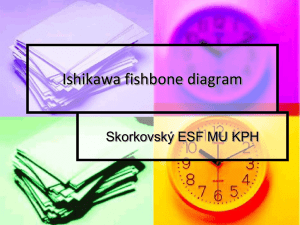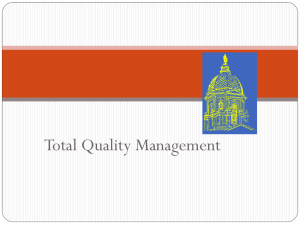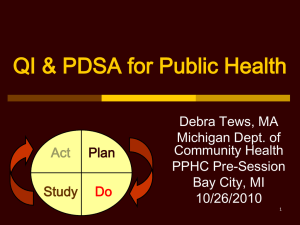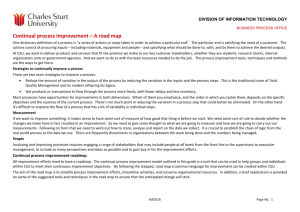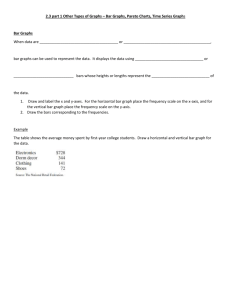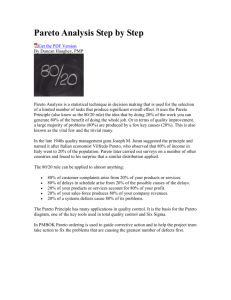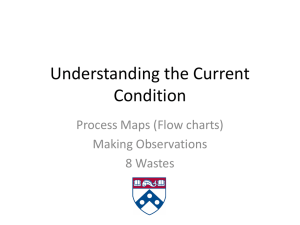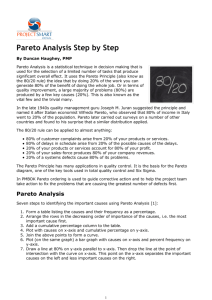Determining Root Causes
advertisement
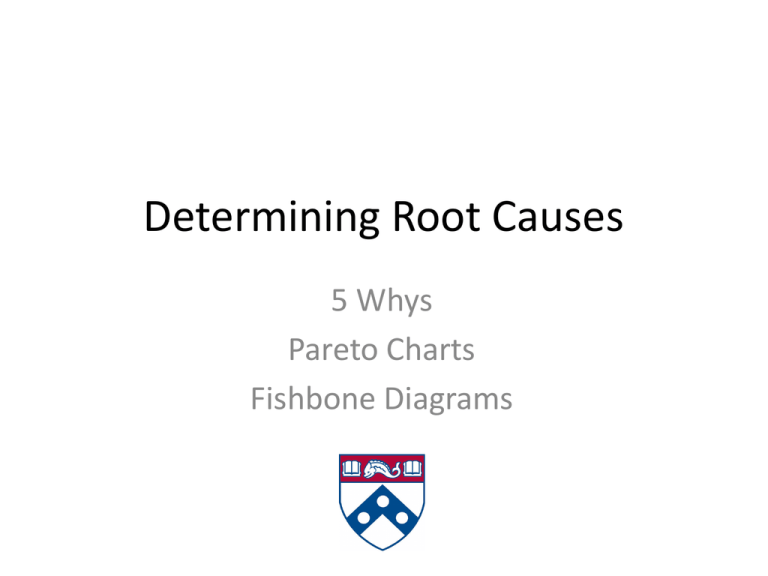
Determining Root Causes 5 Whys Pareto Charts Fishbone Diagrams A3 Roadmap for Performance Improvement at Penn Medicine D F E F I N E I N D Problem Statement (from patient’s/customer’s viewpoint): (10 points) Concise. Customer- focused. Addresses the business case. Shows why a change is needed. Background Provides background for the problem statement (1-3 paragraphs with a minimum of 3 references using APA reference format. Why is this problem important? Who is interested in it (nationally and/or locally) and why? Is there evidence behind this being a problem in healthcare? If so, provide a summary of that evidence. [note: this item will be handed in typewritten, attached to your paper A3] Target Condition: (10 points) Your target condition will move you towards delivering exactly what the customer wants, closer to IDEAL. You identify at least one process, outcome, and balancing measure for your proposed project. You have a clear aim statement, and your process and outcome metrics are expressed as S.M.A.R.T. goals. P I L A N M P R O V E Propose and Test Countermeasures: (10 points) Each countermeasure is clearly related to a root cause in the previous section. For each countermeasure, state how you will DO the tests - What, When and by Whom. A N D D O M O E A S U R E R G A N I Z E C Current Condition: (20 points) There is evidence that you did your “Go and See”. The section is rich with data. Data is presented graphically – bar charts, run charts, or SPC charts are preferred. You have at least one process map (Value-stream, flow chart, spaghetti diagram). The metric(s) you are trying to move are clearly identified. Baseline/pre-test metrics are presented here. Must consider at least one potential process, outcome, and balancing metric You have completed a stakeholder analysis and attached it to your paper A3. L A R I F Y A U N A L Y Z E N D E R S T A N D Metrics/Results: (10 points) Root Cause Analysis: (20 points) You use a relevant root cause tool. (5 Whys, Fishbone, Pareto). Must use at least one tool, though you may need more than one for a deep analysis. Your choice of which root cause(s) to tackle is supported by the data in the Current Condition section – i.e. the data validates that you have identified the true root cause(s) and have chosen the right one(s) to work on first. If a test of change has been implemented, the S.M.A.R.T. goals are restated and results presented as data. Data should be in a run chart or a statistical process control chart (note: this is not required for successful completion of the project for class; some students may not have this item completed yet; see next bullet) If a test of change has not been implemented, describe which countermeasure you have chosen to test first and why. Reflect on What You Have Done and Learned so Far in Improvement work: (10 points) Write a 1-3 paragraph reflection on what you learned by going through this process. What was most challenging and why? What surprised you most and why? What do you think is your biggest challenge going forward? [note: this will be handed in typewritten attached to your A3] Make it Standard Work (Implement Successful Countermeasures): While this step is not required for this class, be aware that failing to execute this step is extremely common in healthcare. Skipping this step is usually the root cause for failing to sustain improvements after attention has moved on to the next project. You should think about how you might implement a successful countermeasure and sustain any improvements. S E L E C T Executive Sponsor Initial Approval (signature and date): Executive Sponsor Final Approval (signature and date): Not required for this class – but never do a real project without this! Not required for this class – but never do a real project without this! C C H E C K O N T R O L or S T U D Y A C T 5 Whys • The simple idea is to keep asking "Why" (usually five times) to ensure that the root cause(s) to the effects are fully understood. • The reasoning is that the result of each time the Why is asked gives a different answer, in essence peeling back the onion as follows: – – – – – First Why—Symptom Second Why—Excuse Third Why—Blame Fourth Why—Cause Fifth Why—Root Cause Asking “Why 5 Times” Drill Down on Possible Causes Problem: Cement is falling from the ceiling because it is being washed several times a week There are lots of pigeon droppings Why? Pigeons come to eat the spiders Why? Spiders come to eat the midges Why? Midges fly to the flood lights of the monument Why? The lights come on before dusk and attract the midges Why? Turn lights on later Pareto Histogram • A type of bar chart showing a distribution of variables. • Represents each attribute or characteristic as a column and the frequency of each attribute or characteristic occurring as the height of the column RNs Leaving Room During An Episode Of Care - 24 hours 35 30 25 C O U N T 20 15 10 5 0 Pareto Chart • • • • A specific type of histogram that ranks causes or issues by their overall influence. A Pareto chart Assists in prioritizing causes or corrective actions as the issues with the greatest impact are displayed in order. In addition, the Pareto chart Includes an arc representing the cumulative percentage of the causes. Pareto’s Law states that a relatively small number of causes will typically produce a large majority of the problems or defects. This is commonly known as the 80/20 rule, where 80% of the problems are due to 20% of the causes. 35 30 25 20 C 15 O U 10 N 5 T 0 100 90 80 70 60 P 50 40 E 30 R 20 C 10 E 0 N T Cause-Effect or Fishbone Diagrams An Error Dissection Tool for Patient Safety Events A Brainstorming Tool for QI Problems Fishbone Pitfalls ! • Avoid Never-Ending Possible Causes – Stay within the team’s “sphere of influence”. • Not using data to back up opinions expressed to confirm the true nature of the causes. • Not using experienced facilitators when possible.


